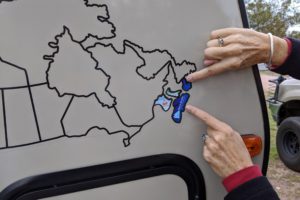Our second look at Colonial Williamsburg takes us to the city’s courthouse, a tavern, the military magazine, a tin shop, and a parade all in the Market Square, the middle of the city. Our first stop was the city’s Courthouse.

In case you’re wondering where we are in the city, here’s the map we followed.

the Courthouse – Rule of the Law
“You are the law! You’re invited to experience local government for yourself. Sit on the jury in this original 18th-century building and discover how the courthouse connects colonists to their community.” (info from website)
The inside of the city’s courthouse is different from what we know today, but what we have today is based on British law. In this picture, those watching the proceedings stand in the area in front of the couple we see. The sheriff and an assistant sit in the boxes on either side of the court where the divider ends so can keep control if trials get rowdy. They also collect fees from the guilty or take them outside to be put in the stocks if they can’t pay.

In front of that floor area before the second railing is the bench for the jury. At the back are 11 seats for judges who are appointed for life. The judge who has been presiding the longest sits in the center chair with the high back. He can be the deciding vote for cases coming before the court.
keeping the law and getting around the law
The sheriff’s job seems to include collecting fines and carrying out punishments, not to investigate if the laws are being withheld. Instead, the citizens are expected to turn in their neighbors if they’re not towing the line. For example, the owners of public taverns had a maximum amount they could charge for someone spending the night or getting a meal. So, of course, if one tavern keeper started charging more, the others would turn him/her in to the authorities. In the next post we’ll see how one entrepreneur got around this law.
One source of fees for the colony was the amount each person had to pay to the Church of England. If someone didn’t pay a monthly amount or attend services during a month, he had to pay a fine. This would have been particularly difficult for Catholics. On the other hand, the local Anglican Church did provide care for those in need, so the monthly fees didn’t just go to the clergy.
British Bill of Rights
Throughout our trip I’ve been listening for how British-based law is similar to or different from what we have today in the U.S. When I heard that Britain had passed a Bill of Rights, I sat up a little straighter since this was new information to me. So I decided to look up what was in this law. This set of laws and our own Bill of Rights is based on the writings of John Locke, one of the most famous philosophers and political theorists of the 17th century. He is often regarded as the founder of a school of thought known as British Empiricism, and he made foundational contributions to modern theories of limited, liberal government.
In 1689, a Bill of Rights was passed that granted freedoms to British citizens. Since our Bill of Rights was based on what the colonists knew and were fighting to retain with the British Crown, I thought you’d like to know what it included. Here are the provisions of the act that I found on Wikipedia.
“The Declaration of Right was enacted in an Act of Parliament, the Bill of Rights 1689, which received the Royal Assent in December 1689. The Act asserted ‘certain ancient rights and liberties’ by declaring that:
- the pretended power of suspending the laws and dispensing with laws by regal authority without consent of Parliament is illegal;
- the commission for ecclesiastical causes is illegal;
- levying taxes without grant of Parliament is illegal;
- it is the right of the subjects to petition the king, and prosecutions for such petitioning are illegal;
- keeping a standing army in time of peace, unless it be with consent of Parliament, is against law;
- Protestants may have arms for their defence [sic] suitable to their conditions and as allowed by law;
- election of members of Parliament ought to be free;
- the freedom of speech and debates or proceedings in Parliament ought not to be impeached or questioned in any court or place out of Parliament;
- excessive bail ought not to be required, nor excessive fines imposed, nor cruel and unusual punishments inflicted;
- jurors in trials for high treason ought to be freeholders;
- promises of fines and forfeitures before conviction are illegal and void;
- for redress of all grievances, and for the amending, strengthening and preserving of the laws, Parliaments ought to be held frequently.”
I had never known about England’s Bill of Rights so found this information informative when its combined with other laws passed over the years.
tavern #1
After all this learning, it was time for lunch, so we stopped at Chowning’s Tavern. Food was okay. Tomorrow’s lunch is much better however!

Magazine – Keeping the Powder Dry
“Listen to the stories of British and American military forces in Virginia as you explore the site where military equipment was stored. This building was constructed in 1715 as storage for the arms and ammunition dispatched from London for the defense of the colony. Just before the Revolution, it was the scene of a famous confrontation between Williamsburg residents and the royal governor, when his soldiers absconded with the colony’s gunpowder.” (info from website)


First we’ll look inside this building and how Governor Dunmore unwittingly contributed to Virginia revolting against England before the news of the Battle of Lexington reached Williamsburg.

The first floor contained powder stored in separate, locked rooms.


The top floor was for military supplies such as blankets, uniforms, and drums (since they were used on the battlefield to relay orders).
Governor Dunsmore’s responsibility for the Revolutionary War
So let’s cover the last British Governor, John Murray, a little more from information I found on Wikipedia. As the 4th Earl of Dunmore, he was known as “Dunmore.” Here’s some of the information I found. I’ll include his interaction with the Colonial Assembly in the next post since it’s part of the Capitol section.
Dunmore’s War: “Dunmore became royal governor of the colony of Virginia on September 25, 1771. Despite growing issues with Great Britain, his predecessor, Lord Botetourt, had been a popular governor in Virginia, even though he served only two years before his death. As Virginia’s colonial governor, Dunmore directed a series of campaigns against the Indians known as Lord Dunmore’s War as he targeted the Shawnee. Dunmore’s stated purpose was to strengthen Virginia’s claims in the west, particularly in the Ohio Country, but as a byproduct it was known he would increase his own power base. Some even accused Dunmore of colluding with the Shawnees and arranging the war to deplete the Virginia militia and help safeguard the Loyalist cause, should there be a colonial rebellion. Dunmore, in his history of the Indian Wars, denied these accusations.
Gunpowder Incident: In the face of rising unrest in the colony, Dunmore sought to deprive Virginia’s militia of military supplies. Dunmore gave the key to the Williamsburg magazine to Lieutenant Henry Colins, commander of HMS Magdalen, and ordered him to remove the powder, provoking what became known as the Gunpowder Incident. On the night of 20 April 1775, royal marines loaded fifteen half-barrels of powder into the governor’s wagon, intent on transporting it down the Quarterpath Road to the James River and the British warship. Local militia rallied, and word of the incident spread across the colony.
Dunmore runs away: The Hanover militia, led by Patrick Henry, arrived outside of Williamsburg on 3 May. That same day, Dunmore evacuated his family from the Governor’s Palace to his hunting lodge in nearby York County. On 6 May, Dunmore issued a proclamation against “a certain Patrick Henry… and a Number of deluded Followers” who had organised “an Independent Company… and put themselves in a Posture of War.”
Refuge on British warship: On 8 June, Dunmore took refuge on the British warship HMS Fowey in the York River. Over the next months, Dunmore sent many raiding parties to plunder plantations along the James, York, and Potomac rivers, particularly those owned by rebels. The raiders exacerbated tensions, since they not only stole supplies, they also encouraged slaves to rebel. In December, George Washington commented “I do not think that forcing his lordship on shipboard is sufficient. Nothing less than depriving him of life or liberty will secure peace to Virginia, as motives of resentment actuate his conduct to a degree equal to the total destruction of that colony.”
Dunmore’s offer to the slaves: He is noted for issuing a November 1775 document (Dunmore’s Proclamation) offering freedom to any slave who fought for the Crown against the Patriots in Virginia. [Of course, if the Crown lost the fight, the freed slaves would be slaves again, and they probably knew that they wouldn’t be treated well by the British anyway.]
Dunmore’s return to Britain: Dunmore fled to New York after the burning of Norfolk in 1776, and later returned to Britain. He continued to draw his pay as the colony’s governor until 1783, when Britain recognized American independence.
Governor of the Bahamas: From 1787 to 1796, Dunmore served as governor of the Bahamas. During his tenure as governor, the British issued land grants to American Loyalists who went into exile. The sparse population of the Bahamas tripled within a few years. The Loyalists developed cotton as a commodity crop, but it dwindled from insect damage and soil exhaustion. In addition to slaves they brought with them, the loyalist planters’ descendants imported more African slaves for labour.
What a guy, right?
Tin Shop – Shaping Lightweight Tools and Utensils
“Soldiers valued tinware for its durability, low cost, and light weight. To supply the army during the Revolution, Virginia’s government established a tin shop to produce kettles, cups, plates, and other items. Stop by to see how our “tin men” snip, shape, and bend this flexible material.” (info from website)
This shop just made products for the military and was only in operation for around 2 years in the 1770s.

His training and knowledge is so specific to what was done here in a 2-year period that Williamsburg will be the only place where he can work in this venue unlike the gunsmith, for example (more about him in the next post).



We were amazed at how wide the streets were, but we know they were wide back in the 1770s because of the foundations of the buildings on both sides of the roads.

One of the docents told us that records from back then said the roads were hard to navigate because of the huge dips caused by rain runoff and overuse. Still, the view of the street is impressive.
Fife and Drum Band
At the end of the day, local high school groups provide a Fife and Drum band to showcase military music in colonial days. Since these bands were used in military campaigns, the uniform colors are opposite of the soldiers who were fighting so they could easily be seen as noncombatants.


Love those parades since I was in marching band in high school. The way they played their fifes was impressive since I played piccolo poorly.
So we’re done for our first day at Colonial Williamsburg. Tomorrow we’ll tour the Capitol section and learn the how and why behind the reconstruction of the city.




